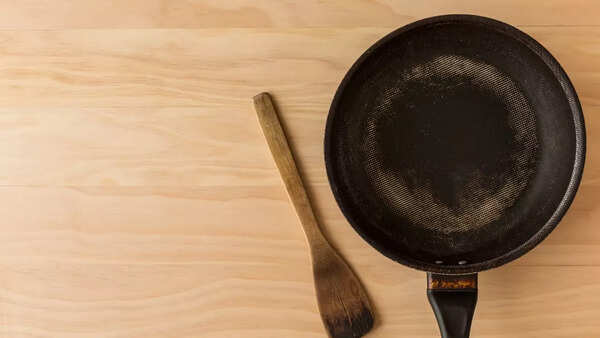Trending
Which is the safest non-stick to buy and when to discard a damaged pan
Learn about the safety concerns and benefits of non-stick cookware. Understand the differences between Teflon and ceramic coatings. Discover how to choose the right cookware and when to replace a damaged pan. Follow maintenance tips for prolonged use.

Non-stick cookware has revolutionized the way we cook, offering convenience, ease of cleaning, and the ability to cook with less oil. However, concerns about safety and durability often accompany these benefits. Knowing which non-stick cookware to buy and understanding when to discard a damaged pan is crucial for maintaining a healthy kitchen environment.
Understanding non-stick cookware
Non-stick cookware typically features a coating that prevents food from sticking, making it easier to cook delicate items like eggs and fish.The most common non-stick coatings include Teflon (PTFE) and ceramic. While these materials provide excellent non-stick properties, they also come with their own set of concerns.
Teflon, or polytetrafluoroethylene (PTFE), has been the standard non-stick coating for decades. It offers superior non-stick performance and is resistant to high temperatures. However, when overheated (above 500°F or 260°C), Teflon can release toxic fumes, potentially causing flu-like symptoms known as "Teflon flu." Additionally, older Teflon coatings may contain perfluorooctanoic acid (PFOA), a chemical linked to various health issues, including cancer. Fortunately, most modern Teflon coatings are PFOA-free.

Ceramic Coatings
Ceramic non-stick coatings are made from inorganic materials and do not contain PTFE or PFOA. These coatings are generally considered safer at high temperatures and are free from toxic fumes. However, ceramic coatings can be less durable than Teflon, potentially losing their non-stick properties over time.
How to choose the safest non-stick cookware
When selecting non-stick cookware, consider the following factors to ensure safety and longevity...
Material and coating
Opt for PTFE-free cookware if you are concerned about potential toxic fumes. Ceramic coatings are a popular alternative. Look for PFOA-free Teflon if you prefer the superior non-stick performance of PTFE coatings.
Durability
Higher quality non-stick cookware generally offers better durability. Look for brands with positive reviews and reputations for long-lasting products. Consider hard-anodized aluminium, which provides a strong base for non-stick coatings, increasing overall durability.
ALSO READ: 7 reasons to rethink using non-stick pans
Heat resistance
Ensure the cookware can withstand the cooking temperatures you typically use. Ceramic coatings can handle higher temperatures than PTFE, making them suitable for searing and browning.
Ease of cleaning
Non-stick cookware should be easy to clean with minimal effort. Check if the cookware is dishwasher safe, but remember that hand washing can prolong the life of the coating.

Brand reputation
Trusted brands often invest in research and quality control to ensure their products are safe and durable. Some reputable brands include GreenPan, Scanpan, and All-Clad.
When to discard a damaged non-stick pan
Even the best non-stick cookware has a limited lifespan. Knowing when to discard a damaged pan is crucial to avoid potential health risks and ensure optimal cooking performance.
ALSO READ: Is your non-stick pan the cause of your health issues? Read this!
Scratches and peeling
Visible scratches, chips, or peeling on the non-stick surface indicate the coating has been compromised. Ingesting flakes of non-stick material can pose health risks, and a damaged surface will no longer provide effective non-stick performance.
Discolouration
Discolouration, particularly dark or metallic spots, can signify that the non-stick coating is wearing thin. This often results from overheating or prolonged use.

Loss of non-stick properties
If food starts sticking to the pan despite using oil or butter, it’s a sign the non-stick coating has degraded. Cooking with a pan that no longer performs effectively can be frustrating and time-consuming.
Age and usage
Most non-stick pans have a lifespan of 3-5 years, depending on usage and care. If your pan is within this age range and showing signs of wear, it’s time to consider a replacement.
WATCH:
Safety concerns
If you notice unusual odours or fumes when heating your pan, this could indicate the coating is breaking down and releasing harmful chemicals. In such cases, discard the pan immediately.
Tips for prolonging the life of non-stick cookware
To get the most out of your non-stick cookware and ensure its longevity, follow these tips…
ALSO READ: The secret why you should never wash your frying pan after cooking
Use low to medium heat
High temperatures can degrade non-stick coatings. Cooking on low to medium heat will preserve the coating and reduce the risk of releasing harmful fumes.
Avoid metal utensils
Metal utensils can scratch and damage the non-stick surface. Use wooden, silicone, or plastic utensils to protect the coating.
ALSO READ: Signs that tell when to throw away non-stick pans
Hand wash
Although many non-stick pans are dishwasher safe, hand washing with a soft sponge and mild detergent is gentler on the coating.
Proper storage
Avoid stacking non-stick pans directly on top of each other to prevent scratches. Use pan protectors or a soft cloth between pans if stacking is necessary.
ALSO READ: 8 types of pans every kitchen must have
Choosing the safest non-stick cookware involves understanding the differences between PTFE and ceramic coatings and considering factors like durability, heat resistance, and brand reputation. Regular inspection of your cookware for signs of damage is essential to maintain a safe cooking environment. By following proper care and maintenance guidelines, you can enjoy the benefits of non-stick cookware while minimizing potential health risks.
(Images courtesy: Canva)
Understanding non-stick cookware
Non-stick cookware typically features a coating that prevents food from sticking, making it easier to cook delicate items like eggs and fish.The most common non-stick coatings include Teflon (PTFE) and ceramic. While these materials provide excellent non-stick properties, they also come with their own set of concerns.
Teflon (PTFE) Coatings
Teflon, or polytetrafluoroethylene (PTFE), has been the standard non-stick coating for decades. It offers superior non-stick performance and is resistant to high temperatures. However, when overheated (above 500°F or 260°C), Teflon can release toxic fumes, potentially causing flu-like symptoms known as "Teflon flu." Additionally, older Teflon coatings may contain perfluorooctanoic acid (PFOA), a chemical linked to various health issues, including cancer. Fortunately, most modern Teflon coatings are PFOA-free.

Ceramic Coatings
Ceramic non-stick coatings are made from inorganic materials and do not contain PTFE or PFOA. These coatings are generally considered safer at high temperatures and are free from toxic fumes. However, ceramic coatings can be less durable than Teflon, potentially losing their non-stick properties over time.
How to choose the safest non-stick cookware
When selecting non-stick cookware, consider the following factors to ensure safety and longevity...
Material and coating
Opt for PTFE-free cookware if you are concerned about potential toxic fumes. Ceramic coatings are a popular alternative. Look for PFOA-free Teflon if you prefer the superior non-stick performance of PTFE coatings.
Durability
Higher quality non-stick cookware generally offers better durability. Look for brands with positive reviews and reputations for long-lasting products. Consider hard-anodized aluminium, which provides a strong base for non-stick coatings, increasing overall durability.
ALSO READ: 7 reasons to rethink using non-stick pans
Heat resistance
Ensure the cookware can withstand the cooking temperatures you typically use. Ceramic coatings can handle higher temperatures than PTFE, making them suitable for searing and browning.
Ease of cleaning
Non-stick cookware should be easy to clean with minimal effort. Check if the cookware is dishwasher safe, but remember that hand washing can prolong the life of the coating.

Brand reputation
Trusted brands often invest in research and quality control to ensure their products are safe and durable. Some reputable brands include GreenPan, Scanpan, and All-Clad.
When to discard a damaged non-stick pan
Even the best non-stick cookware has a limited lifespan. Knowing when to discard a damaged pan is crucial to avoid potential health risks and ensure optimal cooking performance.
ALSO READ: Is your non-stick pan the cause of your health issues? Read this!
Scratches and peeling
Visible scratches, chips, or peeling on the non-stick surface indicate the coating has been compromised. Ingesting flakes of non-stick material can pose health risks, and a damaged surface will no longer provide effective non-stick performance.
Discolouration
Discolouration, particularly dark or metallic spots, can signify that the non-stick coating is wearing thin. This often results from overheating or prolonged use.

Loss of non-stick properties
If food starts sticking to the pan despite using oil or butter, it’s a sign the non-stick coating has degraded. Cooking with a pan that no longer performs effectively can be frustrating and time-consuming.
Age and usage
Most non-stick pans have a lifespan of 3-5 years, depending on usage and care. If your pan is within this age range and showing signs of wear, it’s time to consider a replacement.
WATCH:
Watch: 8 signs you need to throw away nonstick pans
Safety concerns
If you notice unusual odours or fumes when heating your pan, this could indicate the coating is breaking down and releasing harmful chemicals. In such cases, discard the pan immediately.
Tips for prolonging the life of non-stick cookware
To get the most out of your non-stick cookware and ensure its longevity, follow these tips…
ALSO READ: The secret why you should never wash your frying pan after cooking
Use low to medium heat
High temperatures can degrade non-stick coatings. Cooking on low to medium heat will preserve the coating and reduce the risk of releasing harmful fumes.
Avoid metal utensils
Metal utensils can scratch and damage the non-stick surface. Use wooden, silicone, or plastic utensils to protect the coating.
ALSO READ: Signs that tell when to throw away non-stick pans
Hand wash
Although many non-stick pans are dishwasher safe, hand washing with a soft sponge and mild detergent is gentler on the coating.
Proper storage
Avoid stacking non-stick pans directly on top of each other to prevent scratches. Use pan protectors or a soft cloth between pans if stacking is necessary.
ALSO READ: 8 types of pans every kitchen must have
Choosing the safest non-stick cookware involves understanding the differences between PTFE and ceramic coatings and considering factors like durability, heat resistance, and brand reputation. Regular inspection of your cookware for signs of damage is essential to maintain a safe cooking environment. By following proper care and maintenance guidelines, you can enjoy the benefits of non-stick cookware while minimizing potential health risks.
(Images courtesy: Canva)
End of Article
FOLLOW US ON SOCIAL MEDIA










